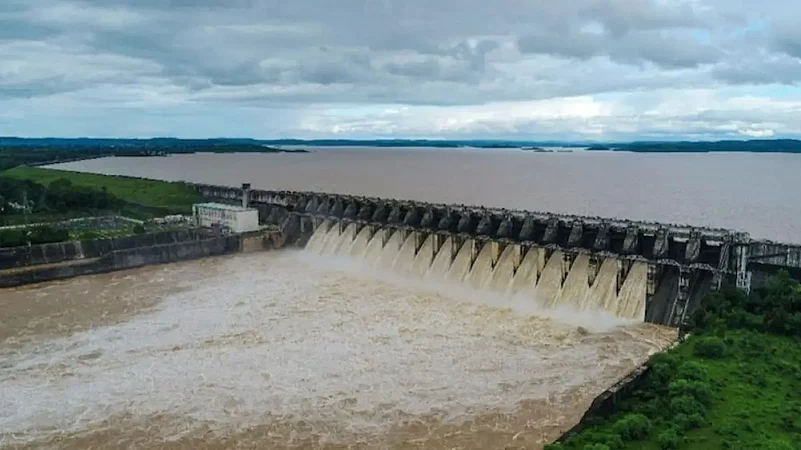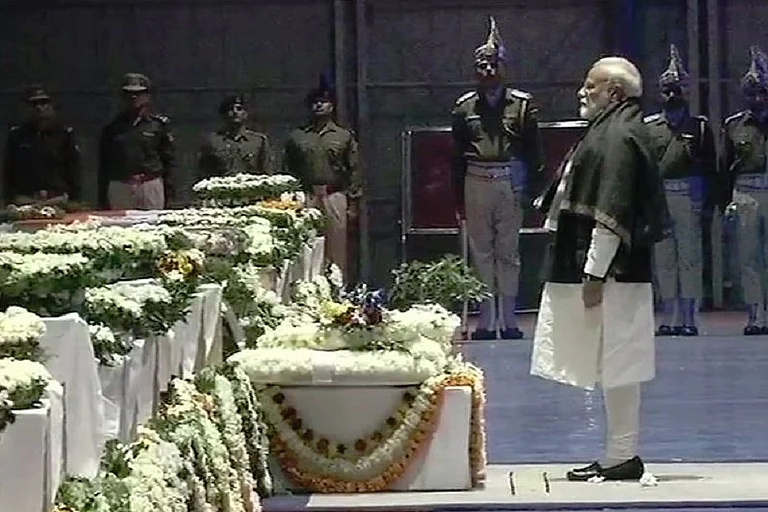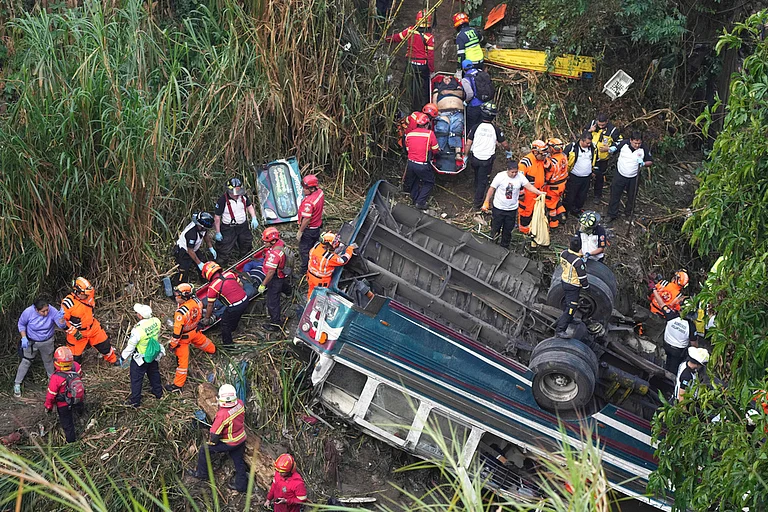Luit parote janam amar
Paniyei pritri shakti aamar
Hei shaktirei baanok rudhim
Hohoshro xatere dupar bandhim
(We are born on the banks of Luit…
The river is our father and our energy
With this energy, we will stop the floods
We will keep it confined to the banks
With the strength of thousand hands…)
This is a song composed by legendary Assamese singer Bhupen Hazarika in the 70s where he speaks about his desire to tame the mad torrent of Luit - the Brahmaputra, the river that causes havoc during monsoon in the state leaving thousands in distress.
The desire to tame a wild river like the Brahmaputra was always in the popular imagination of people in Assam. In 1985, after a six-year-long agitation against illegal influx from Bangladesh, the All Assam Students Union (AASU) requested the then prime minister for a multipurpose dam on the Subansiri. Ironically, this popular opinion changed after one and a half-decade and the same organisation turned against the dam building in the Eastern Himalayan regions of Northeast India.
Arunachal Pradesh, where 169 hydropower projects are proposed to be built, often grabs the headlines mostly for the community resistance against the construction of mega-dams upon the Brahmaputra that flows through Arunachal before entering Assam.
Dams vs Murals
On March 28, when all the power ministers of the Northeastern states, officials of the Central Electrical Authority, and top management of power utilities were at a meeting of the Northeastern Regional Power Committee (NERPC), chaired by Nagaland Chief Minister Neiphiu Rio in Guwahati, news broke out; The Arunachal Pradesh Police arrested an anti-dam activist and another graffiti artist the other night for defacing a mural in capital city Itanagar that was installed to showcase the hydropower development of the state. A “No more dam” slogan painted on the Wall of Harmony, shifted the attention from India’s progress in generating what it calls clean energy from the Himalayan states of the Northeast to the issue of the environment and social viability of big dams once again.
Ebo Mili, a lawyer cum anti-dam activist from Arunachal Pradesh and Nilim Nayan Mahanta, who hails from Lakhimpur district of Assam, one of the downstream districts, got released on bail after two days.
“We want sustainable development. We are always with nature and communities. I am an artist and I have some responsibility. If something goes against nature we have to speak up,” Mahanta said to reporters after his release on the condition that he had to repaint the mural within the next 10 days and bring it back to its original form with the assistance of Ebo Mili.
Arunachal Pradesh Chief Minister Pema Khandu, who hails from the Bhartiya Janata Party (BJP), had already termed any opposition against development projects as ‘anti-national’.
On Tuesday, an anti-dam group, the Citizens and Groups of Anti-Dam Movement said, “If dams are a part of our reality as Arunachal Pradesh celebrates its 50th anniversary of statehood, the opposition to the dams is also part of the reality. If murals of a dam can be painted over walls of our cities, juxtaposed right next to our rich eco-cultural heritage, then appealing to protect and nurture our rich bio-cultural heritage, origins and history with art should also be part of the cityscape.”
Anti-dam movements
Anti-dam movements in Northeastern states date long back. When a massive earthquake in 1950 ravaged Assam and changed the course of the Brahmaputra and lifted its bed with heavy siltation from the mountains of Arunachal Pradesh, the need for dams was first felt in the region. The other aim was to supply water during the drought season for irrigation purposes and of course to reduce the deficit of electricity. This included the ambitious Dibang multi-purpose project and the Lower Subansiri mega-dams – the two dams which rallied the most intense community resistance in upstream Arunachal Pradesh and downstream Assam. However, the Arunachal Pradesh government opposed the proposal initially.
Decades later, Assam was the first state to carry on a protest against mega-dams led by the All Assam Students Union, the organisation that vowed for dams in 1985.
The protest took the shape of a mass movement, especially after June 2008, when excess water was released from the Ranganadi dam, the first dam of Arunachal Pradesh located in Yajali in Lower Subansiri district on Ranganadi river, a north bank tributary of Brahmaputra, without a prior warning to downstream communities. It led to a massive flood during the peak summer submerging large swathes of land, killing at least 10 people and affecting around three lakhs.
Floods due to dams
Since 2001, when the 68-metre high Ranganadi dam got operational, massive floods creating havoc in downstream areas became a yearly phenomenon. It led to a drastic change in topography in the Lakhimpur and Dhemaji districts of Assam. Sand depositions replaced green lush landscapes with dried up rivers and sandy floodplains.
Between 2008 and 2019, water from the 405 MW dam breached dikes several times, making downstream communities, and ecological experts ponder upon the safety of the design of Ranganadi. In July 2017, 11 people lost their lives again, due to an embankment breach by the surplus water. This led to the demand for decommissioning the dam.
On 9 February 2019, the Ranganadi River, which originates from the Dafla hills of Arunachal Pradesh turned black and turbid due to the release of an unprecedented amount of silt from the same dam. This led to immense destruction of aquatic life - at the banks of the river at Lichi, Upper Sher, Lower Sher, Boda, Upper Jumi and Komasiki village areas.
The Jumi, Komasiki, Cher Green Plus Society (JKCGPS), a local NGO said, “The mud water released by NEEPCO Ltd on 9 February has almost killed all the aquatic life in the river, which has created panic among the people in the downstream areas,” It also filed a police complaint against the project head of the dam.
However, even after 20 years of operation of the dam, no post-dam environmental assessment has been conducted either upstream or downstream.
With the Ranganadi dam, the communities in upper reach and lower reach had got a taste of the havoc of a poorly managed dam. So when a mega-dam, five times higher than the capacity of Ranganadi, started building up in Gerukamukh on the Assam-Arunachal Pradesh border, people’s movement took a fierce turn. In 2011, thousands of people from downstream communities in Assam blocked the Ranganadi bridge for weeks, which was used to supply raw materials for the construction of the 2,000 MW Lower Subansiri Hydro Electric Project, built on Subansiri. The Assam Police tried to suppress the movement by arresting the leaders of the movement.
Between 2001 and 2012, Assam and Arunachal Pradesh saw a fierce people’s movement against the Lower Subansiri Hydro Electric Project. The project report of the dam was prepared by the Brahmaputra Board, a central body set up in 1982 to work towards controlling flood and bank erosion caused by Brahmaputra and Barak rivers. However, strong resistance came from the then Congress Chief Minister of Arunachal Pradesh, Gagong Apang.
In 1995, Apang, though consented to the board to study the river basin and its downstream impact, directed the board to come up with an alternative plan.
The Board later came up with a plan for setting up six smaller dams instead of one mega-dam. The purpose of these dams was multi-dimensional. Apart from electricity generation, its focus was supposed to control downstream floods and irrigation during dry months.
Resistance
However, after a couple of years when the Atal Bihari Vajpayee-led National Democratic Alliance came to power in 2001, it handed over the project from Brahmaputra Board to the National Hydro Power Corporation (NHPC). The NHPC again converted the multipurpose dam into a single purpose dam, with a height of 115 meters for generating electricity and began construction of the same without a downstream impact study.
This is when resistance started to build up among downstream communities. The main demand of the movement was a study on downstream impact apart from upstream submergence and displacement. In June 2010, a report released by an expert committee formed to study the downstream impact created panic.
“The selected site for the mega-dam of the present dimension was not appropriate in such a geologically and seismologically sensitive region. Therefore it is recommended not to construct the mega-dam on the present site,” said the report.
The expert committee composed of members from IIT Guwahati, Dibrugarh University and Gauhati University expressed reservation over the dam over inadequacies in the spillways for releasing floodwater that can cause havoc downstream.
The main flak that the Lower Subansiri Hydro Electric Project faced was for ignoring the flood control aspect and compromising on the dam’s design and safety.
Various environmental groups including the AASU, and Krishak Mukti Sangram Committee (KMSS), demanded an immediate stoppage of work on the dam leading to a halt in the construction work after December 15, 2011.
In January 2013, a technical expert committee was formed under the Planning Commission to review two aspects of the Subansiri dam -- one is on dam design and safety and the other was on operational management, i.e. reservoir management to control flood effectively. However, the anti-dam lobby rejected the report of the expert committee. A massive movement led by Akhil Gogoi, now MLA and then leader of Krishak Mukti Sangram Samiti, followed the next couple of years.
After nearly two decades of the movement followed by the legal impasse, in December 2021, the Supreme Court finally cleared the deck for the resumption of construction work of the dam after it dismissed a petition filed against the National Green Tribunal that gave a green signal of NHPC to start the construction. A few days later, Union Minister for Power RK Singh in Guwahati announced that the dam will be operational by August this year. Following the statement, the state saw a new spat of protest once again.
After a failed resistance, here comes India’s biggest and the world’s largest concrete gravity dam – the Dibang Multipurpose Project, popularly known as Dibang dam set to be built in the Dibang valley. Pegged at a capacity to yield 2880 MW, the dam is to be constructed by felling 2.7 lakh trees and clearing 1,165 hectares of forest land that is also a biodiversity hotspot and home to the Idu Mishmi community of Arunachal Pradesh bordering Tibet and China. The project comes at the cost of displacing hundreds of families in 39 villages of Dibang Valley.
Though the project was inaugurated by then UPA Prime Minister Manmohan Sigh in 2008, the NHPC could not progress the construction due to unanticipated opposition from the Idu Mishmi community which comprises 1.3 per cent of the state population of Arunachal Pradesh. The project stalled from 2008 to 2013 owing to massive protests. However, the protests were suppressed by the state government by the use of para-military forces. Despite being denied forest clearance twice in 2013 and 2014 for potential environmental hazards and loss of biodiversity, the project got a nod from the Ministry of Environment, Forest and Climate Change in 2015. In 2018, NGT gave a go-ahead to the project.
Nogoro Melo, President of the Dibang Multipurpose Project Dam Affected Area Committee, an anti-dam organisation belonging to the Idu-Mishmi tribe said, “The tribal people know the value of the land. But the government and the dam authority are snatching the land of around 4000 hectares (including submergence) by paying a meagre amount. In the Dibang Valley district, the estimated compensation by the government to be paid to the people was Rs. 1600 crore. But NHPC has challenged this order saying that the land does not belong to the people. The protest against such exploitations will only grow bigger.”
Notably, prior to the Assembly polls of 2019, the Arunachal Pradesh government announced a compensation package to the affected people of the project living in the 1,732.45 acres of land where the Dibang dam is being built and ordered NHPC to deliver the amount. However, after the election, the NHPC challenged the order in court. It stated that the land was unclassified and did not belong to any individual. After three months, the Narendra Modi government gave a go-ahead despite not having received Stage II forest clearance and the compensation issue not being settled.
“Since India’s independence in 1947, the construction of 4,300 dams cumulatively has displaced more than 4.4 million people. A study by the World Bank indicated that on average each dam displaces 13,000 people in India. These are very serious concerns that should have been a part of the public consultation while proposing these dams. Instead of a healthy environment which takes concerns of the citizens of this country into its account, the right to dissent in the light of these facts has been completely violated by the present Arunachal Pradesh government," stated Citizens and Groups of Anti-Dam Movement.
However, Mirza Zulfiqur Rahman, an independent researcher from Northeast India and someone, who has been closely monitoring the behaviour of the Brahmaputra, feels that due to a lack of solidarity between communities anti-dam movements across the borders have not been able to put up a strong resistance.
Speaking to Outlook, Rahman said, “Most of the anti-dam movements have weakened considerably over the past 10-15 years. There is a lack of solidarity movements across internal borders of Northeast India on major environmental activism. Without any such strong solidarity movement across these borders, the issues become very fragmented.”
Rahman is right while saying so. The border disputes between Assam and Arunachal Pradesh date back to colonial times with frequent flare-ups giving rise to an atmosphere of distrust among communities on both sides of the region and the states.
Dam Safety Act, 2021
After 42 instances of dam failure and 34 years of deliberation, the Indian Parliament in December passed the Dam Safety Act 2021. This act is to “provide for the surveillance, inspection, operation, and maintenance of the specified dam for prevention of dam failure related disasters and to provide for an institutional mechanism to ensure their safe functioning and for matters connected therewith or incidental thereto.
The need for a dam safety law was first felt about three decades ago when the Machchhu II dam in Morbi in Gujarat washed away embankments and villages in 1979. The exact number of deaths ranges from the Government's 1000 to the opposition's 20000.
However, Dam Safety Bill 2021, is drawing flak for allegedly trying to usurp the power of the state governments. Many legislators from the opposition termed the bill as an assault on the federal structure of the nation, accusing the centre of encroaching upon the power of the state governments by trying to regulate a state subject. So far, 92 per cent of India’s dams are owned and maintained by the state governments.
On March 25, hundreds of farmers from Punjab and Haryana came out in protest against the Dam Safety Act 2021 alleging that the bill was passed to entertain corporate houses in the country by paving way for the privatisation of dams.
Another major criticism that the bill is facing is for not talking about compensation for the people who might get impacted by dam-related accidents. A petition has also been filed in the Madras High Court challenging the act.
Amidst such developments, a recent report on Glacier Inventory on the Subansiri river basin on the Brahmaputra has renewed concerns about the safety of big dams in the Northeast no matter how tight is the Dam Safety Act. The study for the first time included the entire Subansiri basin irrespective of the geopolitical boundaries that divide India and China. The study which was published in the Geological Journal of Wiley recently reveals that 30 per cent of the glaciers in this part of the region are retreating rapidly. The findings of the study are concerning because of the fact that the upcoming dams will be at threat of a sudden glacier meltdown.


























